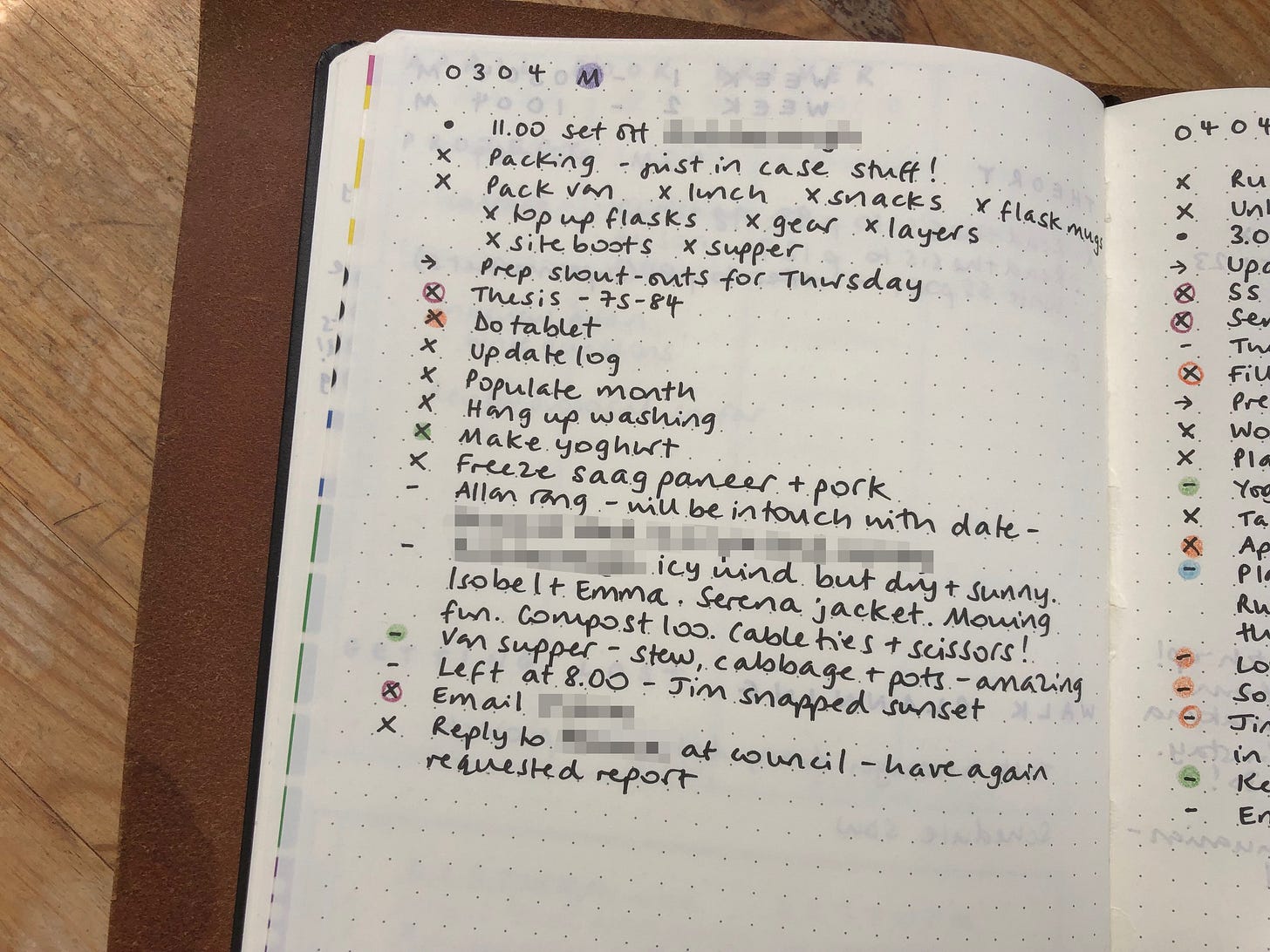62. The shopping list as wayfinder
How to navigate a supermarket - and without impulse buying or overspending!
Dear Reader,
I’ve said it before but I’ll say it again: I love a list.
When I was tiny I’d write a list for Father Christmas, or a birthday list of the treasures my heart desired in the build-up to my big day.
But plenty of other lists feature in my life today, such as the rather less self-orientated household shopping list, or the packing list to organise every trip in the campervan. Downstairs in the kitchen I have a single page comprising several lists: it shows me what ingredients are waiting in the fridge for the domestic goddess iteration of myself to turn into delicious plats du jour, my freezer inventory and my meal plan.
The daily log in my bullet journal always begins with a list, evolving as the day goes on into a longer one. Besides that, though, it is a log of things I want to remember, a dumping ground for any exasperations that I have needed to download, or a note of anything else I’ve wanted to jot down. At the end of each day my daily log stands as a list of my accomplishments, an ink-on-paper record of achievement.

Use your shopping list to find your way around the supermarket.
Lists have many different uses, and I’ve been exploring the idea of the list as a wayfinding tool in a shopping environment.
As a younger person out in the world for the first time I never used to plan a thing, let alone write a shopping list. Back then I even used to consider the supermarket shop as a treat1. Finally in charge of my own destiny – responsible, as my head teacher put it in our final assembly before we left school for university, for ‘buying your own toothpaste’ – the aisles of my new local supermarket were an impulse buyer’s treat-seeking playground. Living in student accommodation and with my shopping trips guided only by the supermarket layout and its bright signs, my path through the store would be determined by colours, bold graphics and the promise of gorgeous treats. Biscuits! Multipacks of crisps! The build-your-own pizza section! I’d spend an hour in there, eventually pushing my brimming trolley away from the checkout while my confused brain tried to work out quite how I’d managed to spend so much money. And gosh, it was no wonder that my clothes were getting tighter. 🫣

In his PhD thesis “Finding Our Way: A Socio-Cultural Exploration of Wayfinding as an Embodied Experience” Paul Symonds considers a supermarket shopper’s ‘background knowledge’, stating that ‘wayfinding in a large supermarket… might be easier if a person has previously used a supermarket owned by the same company and has a level of familiarity with their standard store layout. Likewise, aspects of the practical logics of this system of organisation will also transfer to other supermarket layouts too. This familiarity… so relevant in wayfinding… enables people to find their way relatively more easily…’2
Indeed, wayfinding is easier on familiar ground. When we know our surroundings, we are perhaps less likely – although not always, as you might have read in my last post – to lose our way.
As a more mature adult, but before I discovered the joys of online grocery shopping for delivery, for the purposes of both convenience and the familiarity mentioned by Symonds I would always frequent the same supermarket for my weekly shop. Yet for a while living at home again as a boomerang kid an adult, I wasn’t responsible for shopping for the household. Sure, I did my chores, and did the best I could to be an active part of the family while I steadied myself back onto wobbly foundations, but at no point was I left to my own devices in a supermarket.
Yet once I was living within my own four walls again, as the head (and tail) of a solo household, I needed to stand on my own two grocery-shopping feet. My weekly trip to the supermarket was up to me.
Cards on the table: I am socially averse. I don’t enjoy busy environments, and these days I go out of my way to avoid crowds. Reader, going to a supermarket right now is up there in the edited highlights of my showreel of worst nightmares.
Out on my own again, at first the experience would be confusing: the aisles of Tesco were a disorientating blur. Where was everything? How do I do this? Where do I even start?
Tesco itself, of course, could help me there. Their store designers could be trusted to get me from the store front to the checkout without missing a thing.
‘Supermarkets aren’t designed to simply fulfil needs. They are a carefully-designed journey of behavioural clues and sensory experiences with one simple aim: getting you to spend more.’
From ‘Supermarket Psychology: How They Use Science to Make Us Spend More’ – by Hustle Escape
And Reader, that’s the problem. We’re hardwired to react to cues on our supermarket journey in a predictable manner, and the supermarkets know it. They adopt all sorts of tricks that are designed to pull an unsuspecting shopper off-piste and into the reckless downhill slalom of impulse buying:
Placing tempting treats at aisle ends, where we have to slow down to turn our trolley into the next aisle;
Positioning the branded, more expensive products at easy eye level;
Locating common, popular items such as milk in the furthest corner, forcing shoppers to traverse the entire store to get to them. And yes, it takes time and a roundabout route for customers to get there, increasing their likelihood of adding tempting treats to their trolleys.
Of course, there are many ways to navigate around stores, and I don’t just mean supermarkets. The planners at IKEA, for instance, have conveniently plotted our route using large arrows on the floor for us to follow, and woe betide any of us who are trying to confront the stream of traffic in the wrong direction, or worse, buck the system by nipping through any cheeky shortcuts we might find between those dreamy room sets and teetering piles of Swedish-designed lunchboxes.

IKEA steers us the arrow-determined way not for our sake but for its own. Never mind our convenience, time, available budget or sanity (we left the last of these behind, let’s face it, at the door): the bottom line – theirs, not ours – trumps all of those. The longer we spend in the store, the more products and set-ups we pass, the more we are likely to buy. And that’s pretty much the same for all shops. Cha-ching!
(Okay, I’d get lost without the arrows. We all know this. 😉 But the point remains that they’re a great way for IKEA to engineer their shoppers’ experience.)
Now, I’ve no say in the structure of a supermarket; of how my grocery shopping experience is presented to me as a user. But Reader, I have agency: I can choose how to behave in this pre-programmed scenario.
Yes. I can work this out to suit me.
Here’s how it works:
Living alone again after my relaunch, instead of using the supermarket’s own cues to determine my route around it, I decided to bring out my secret weapon: using my shopping list as a wayfinding tool.
In my kitchen at the time I kept a wide-ruled wire-bound A5 notebook. Leaving the right-hand page blank, throughout the week I’d be scribbling down the things I knew I needed to pick up on my next trip to Tesco as I thought of them. Clipped securely into the front of the book was a standing list of my without-fail weekly necessities, and when shopping day dawned I’d make a large cup of tea and sit down at the table with the notebook.
This is where the blank right-hand page would come into its own. Visualising the layout of my local supermarket in my head and the order in which the goods were presented – first fruit and veg, then deli meat, fresh meat, frozen veg etc – I would populate the page with items listed on the left-hand page, as well as the clipped-in list of necessities, in supermarket-layout order.
Having that cuppa and putting the items on what had been an altogether much more random list into the order in which I would come across them in the supermarket was time very well spent, and it certainly kept me away from the temptations of pricey and unnecessary impulse buys.
I was happy to substitute any alternatives priced cheaper on the day: instead of a pork roast for Sunday lunch I might have picked up a reduced hunk of rolled brisket instead, for instance, but otherwise, if wasn’t on the list, it didn’t belong in my trolley.
My list would save me stress, time and money, and would guide me around the supermarket without causing me to feel bewildered and disorientated. Nor would I get distracted.
And now that it is no longer my habit to shop in a supermarket? Reader, my list comes into its own in the online grocery shopping environment, too:
I don’t browse the different categories: I use the search box to find only the items that are on my list;
Because the online shop adds up my proposed purchases as I go, I don’t lose track of my spending. First I see if anything on my list is available at a reduced price, and this is easy, because the search results are populated on the screen with the items on offer at the top. Later, if I find I have exceeded my budget, I can go back and select cheaper equivalents for certain items, or choose more cost-effective cuts of meat. Perhaps I’ll take the opportunity at that stage to plan a more frugal meal or two that week.
And Reader, those impulse buys still don’t get a look-in. Why not?
They’re not on my list.
Not only is my made-to-measure shopping list an excellent wayfinding tool, allowing me to get around a supermarket as quickly and efficiently as possible, it also delivers me from the temptations of impulse buying and overspending. And with cost of living easily earning its place at the top of my list of concerns, that is absolutely a good thing.
Love,
Rebecca
I’d like to just finish this post by sharing my thoughts on Substack Notes.
I love that Substack is constantly and consistently innovating its platform, and the latest string to its bow is Substack Notes.
I used to be active on several traditional social media platforms, but waved goodbye to those particular cyber-relationships several years ago in order to take better care of myself. I feel that diving into Notes – which reminds me rather of a particular competitor on the social media playing field – might leave me feeling vulnerable.
For now, then, I am happy to continue to plough my existing Substack furrow without my attention being distracted by the shiny lights of the Notes platform.
This doesn’t mean I’m antisocial! I both enjoy and deeply value engaging with readers in the Comments sections of my posts. 😊
If you’ve enjoyed this post, do please let me know by clicking the heart. Thank you!
Thank you for reading! If you enjoy ‘Dear Reader, I’m lost’, please share and subscribe for free.
If you’ve been following my correspondence with my fellow Substacker Terry Freedman you’ll know that it’s my turn to reply to him on Wednesday! You can find his latest letter to me here, and links to our entire canon of letters here. Do have a read of our light-hearted exchanges about British life over our shoulders!
My next ‘Dear Reader, I’m lost’ post will of course be published next Saturday.
Yes, the mad, impetuous fool that I was at the time. 😳
Symonds, 2017: “Finding Our Way: A Socio-Cultural Exploration of Wayfinding as an Embodied Experience”, p82.





I think I’m the opposite of everyone here - I love to go to the grocery store! I’ve never used the online pick up (I live a mere 400m from the closet grocery store, so even if delivery was available I don’t think I could bring myself to use it). In fact, yesterday after work I did my weekly shop. I do use my list pretty strictly too, and carefully meal plan to avoid impulses (I allow them for in-store specials of things I would buy/use anyway, if they weren’t on my list). I rarely wander the store idly, and I think that helps, as you’ve found.
Oh, the list...sometimes, I find a list frees up my mind, and other times, I find it constricts me. There is no doubt, in the supermarket, it does save me money. List On!